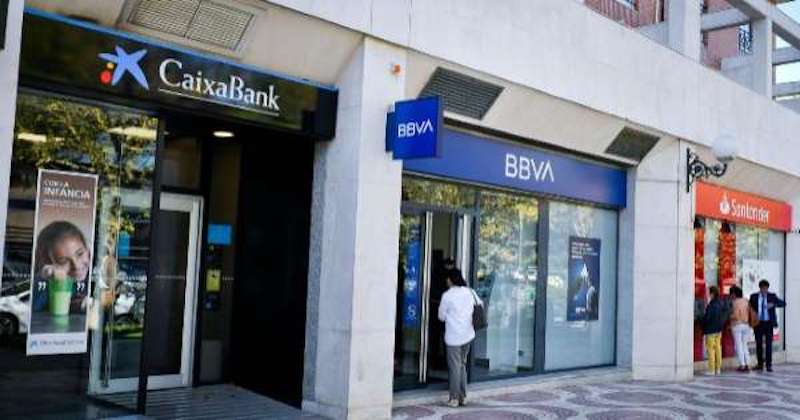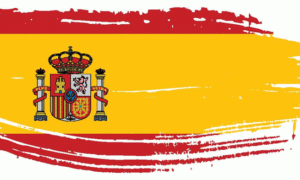(Editor’s note: Confused about why you can use PIN cards in the Netherlands but often can’t use cash, yet you need cash for many transactions in Germany and can’t use PIN cards? So are we. This post about the latest digital banking and payment options in Spain is the third installment in Dispatches’ expat financial services series and will be updated with new FinTech and services. Read more here about personal finance and other expat essentials.)
One thing any visitor to Spain very quickly learns is that nothing but nothing is straightforward. Immigration offices, town halls, police stations, medical centres to name but a few all have their own and unique way of doing things and at times it can be very frustrating, and so trying to advise someone even with regard to the simplest of tasks can be problematic.
Banks are no exception to this rule.
The first thing you’ll notice is that their opening hours are typically from 8:30 a.m./9 a.m. to 2 p.m. /2:30 p.m. Nearly all are closed in the afternoon and more often than not you’ll need to make an appointment except for using the cashier services. However, beware there can be long queues and even the short queues seem to take an eternity to clear.
My advice – take a good book and some sandwiches.
English is rarely spoken except of course for the expat/tourist areas so you may need to brush up on your Spanish. Google Translate often comes in handy.
Unlike in the United Kingdom, each and every bank has their own network of cash machines rather than for example being part of a network of machines such as LINK in the UK. That means each time you visit a cash machine belonging to a different bank you’ll get charged up to 3 euros.
Thankfully, most shops, bars, and businesses in the more populated areas accept cards, contactless (chip) or otherwise, and surprisingly some – particularly the larger stores – accept the likes of Apple Pay.
Nevertheless cash is still king and in the smaller towns and villages visitors do need to be aware that not every bar or business will accept cards.
If you do need to use your card either to withdraw money from your UK account using a cash machine here in Spain or to make purchases in shops and bars, you should always be given the option of paying in either Pound Sterling (GBP) or in euros.
Choosing the Euro option means that your bank at home in the UK will make the conversion from Euros to GBP; whereas choosing to pay in GBP means that the Spanish bank will carry out the conversion. This is important because more often than not you’ll get a better rate from your UK bank (depending on the type of account that you have) than that on offer from any of the Spanish Banks.
I mentioned previously that you should get the choice of paying in Euros or GBP, cash machines are not really a problem and as a matter of fact I can’t ever recall having not received this option. However that is not always the case in shops and bars possibly because they would, let’s say prefer you to pay in pounds given that (depending on their bank) they will receive a small commission.
We are not talking huge amounts here – maybe 7 euros or more on a 200 euro withdrawal (3 euros in withdrawal fees and 4 euros taking account of exchange rate differences), but still enough for a caña or three.
Go virtual
TIP:
If you are a frequent visitor to Europe you would do well to consider an account with one of the digital challenger banks (Monese, Revolut, N26 or Transferwise).
• All are very easy to apply for and they offer largely free day–to–day banking in a whole range of currencies;
• There are no monthly or annual fees;
• There are no charges for chip and PIN cards or contactless transactions;
• There are no fees for standing orders or direct debits;
• Best of all, there are no foreign exchange fees and their currency conversion rates are as good as you’ll get (see XE.com for current market rates).
They also offer security and peace of mind. On the one occasion I managed to lose (or possibly a thief stole) my Monese card in Madrid, I simply blocked the card using the app on my phone and requested a new one, all very easy and stress free.
Bank Accounts
If you are a resident, in the throes of moving to Spain or looking to buy a house you will require a Spanish bank account with a Spanish IBAN (account number). It’s important for many reasons, not least because without one you’ll be hard pushed to find any gas, electricity, water or telephone provider willing to provide their services.
As with the NIE, so many things in Spain depend on you having a Spanish bank account (including a Spanish IBAN) even down to simple things like gym membership.
To open a non resident (or resident) account you will typically need the following;
• Passport (or other acceptable proof of identification)
• Número de Identidad de Extranjero (NIE)*
• Proof of address
• Proof of employment status.
• UK National Insurance Number**
• TIE or Certificate or Residency (only If you are a resident)
* Again I say typically because not all banks and not all branches follow the same rules. The NIE is a prime example. I asked my local Bankia branch manager here in Granada if it was possible to open an account without an NIE. Her response was an emphatic, “No.” Yet by the same token I know of people who have opened accounts with Bankia without having an NIE, only a passport.
**My son was asked to provide his UK National Insurance Number as a condition of his opening a non-resident account with Sabadell. Yet I opened my non-resident account with only my passport at the same bank, but at a different branch.
Bank charges
Some banks will charge fees, some won’t. Some require you to take out life insurance or home insurance; others will require you to make regular payments or to keep a minimum amount in your account. Again, it’s down to the local branches, which seemingly have a fair amount of discretion in these matters. (I know this from personal experience.)
So the golden rule is ask around – local Facebook groups are a great place to start because there’s always someone who has just done it and can point you in the right direction or give their views on specific banks.
TIP:
Once more back to the digital banks. N26, which is a virtual German based bank, offers an account that does give you a Spanish IBAN. It’s all app-based and certainly worth a look. You can set up an account on your mobile phone within a matter of a few minutes without any paperwork or knowledge of Spanish. All that is required is a compatible smartphone and some valid ID, which you’ll use to verify your identification in a quick video call, or via photos.
Banks to consider
Would I recommend A bank? Not really. We’re with Bankia. We have an Cuenta One account that is free in terms of charges but it’s an internet-based account, so we’re not allowed to use the cashier service (though we do). Personally I can’t fault them. However, like all banks (and the same applies to the UK) they have have their detractors.
Here are the Top 5 (ranked by assets) to consider:
Santander – The largest Spanish bank and voted best bank by The Banker Magazine in 2019, though if you trawl the internet widely enough I’m sure you could find similar awards for each of the Top 5 banks listed here. Banco Santander of Spain shares the same name as the Santander Bank in the UK but that is where the connections end. They are separate entities, so don’t expect to be treated any differently to any other new customer.
BBVA (Cuenta Online) is commission free and has a really good multi-language website. BBVA is consistently voted to be one of top three banks in Spain and awarded Best Digital Bank in Spain by The Banker Magazine (part of the Financial Times group)
Caixa- (pronounced Ka-Shah) Named the best bank in Spain 2020 by Global Finance Magazine, and to be fair I’ve had dealings and found them helpful and with a great website! Currently merging with Bankia.
Sabadell – I’m struggling to find a recent “best bank award” for Sabadell, which maybe isn’t so surprising given that there are lots of reports of multiple charges and they do get some bad press on social media. I’ve not yet found a free account (they seem to require a minimum monthly deposit of 700 euros). However, again a really good easy to navigate English language website.
Bankia– Their Cuenta One account is commission free and I can add from personal experience that it has a good English language website. Currently in the process of merging with the Caixa, Bankia was awarded the 2020 Cegos Award for Best Practices in Human Resources.
We are always interest to hear your views (the good the bad and the ugly) on Spanish banks, so please drop us a line or leave a message in the comments section. And don’t forget to visit our Facebook group for all things Spanish.

About the author:
Irina Greensitt is from the far eastern town of Khabarovsk in Russia, but has previously been living in the United Kingdom for seven years before moving to Spain in 2014 together with her husband and two young children.
Irina now runs an internet business and lists walking, travel and sailing (passing her skippers exam in 2016) amongst her hobbies.
See all of Irina’s posts here.
See more from Dispatches’ Spanish archive here.














